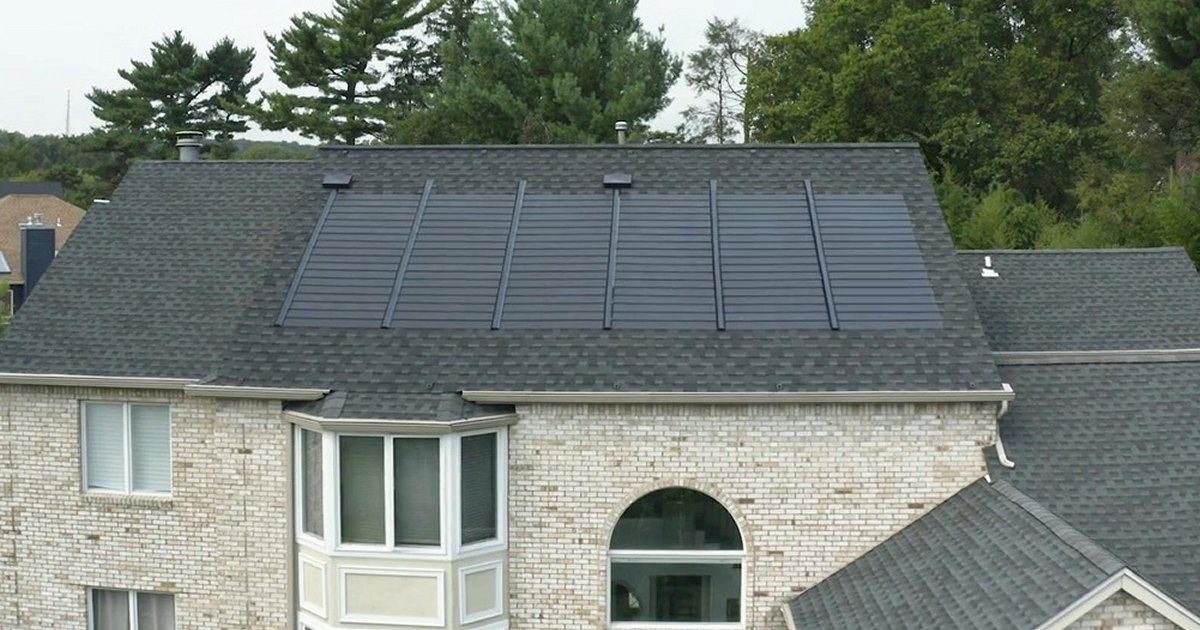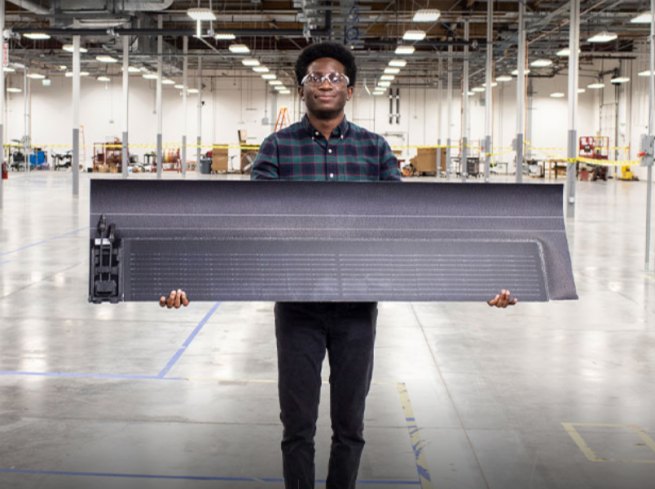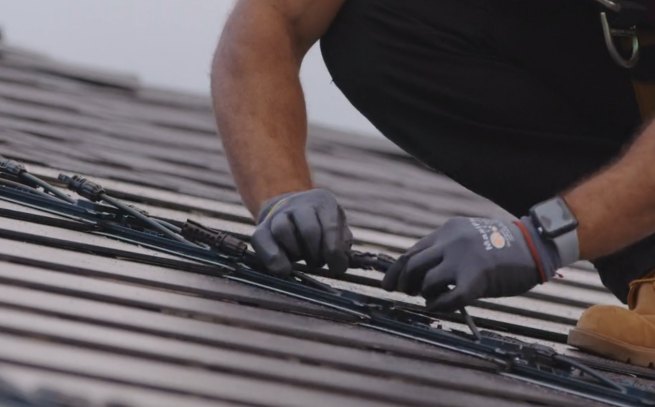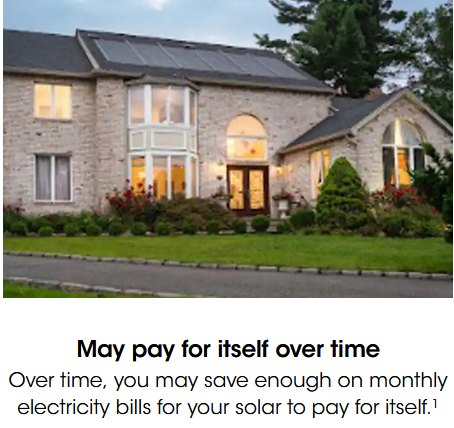
US company GAF Energy unveiled its Timberline Solar roof shingle product yesterday, and it’s created a fair bit of buzz.
GAF Energy’s sister company GAF seems to know a thing or two about roofing. The company claims that of the five million new roofs installed across the USA each year, a quarter of those come from GAF – so its move into developing a Building-Integrated PV (BIPV) product isn’t suprising.
“Solar roofs are the future of clean energy, and Timberline Solar is the game-changing innovation that will get us there,” said Martin DeBono, president of GAF Energy.
The shingles come in long strips with connectors on the front face, which are protected by conduit when installed. All that’s needed for installation in terms of tools is a nail gun, wielded by a GAF certified installer.

This isn’t a retrofit solution – it’s for new roofs or for full roof replacements.
The nailable Timberline Solar shingles are warranted to withstand winds up to 130 mph (around 210 kph). Just on warranty, there’s 25 years of coverage against manufacturing defects that cause leaks, 15 years against wind damage caused by winds up to 130 mph and 25 years of coverage for performance. I didn’t see mention of a specific product warranty, but that’s assumed to be covered under performance1. There are also extended warranties that can be purchased.
Show Me The Money (And Specifications)
GAF Energy did a bang-up job of getting attention for the Timberline Solar launch, but is vague in its promo on a lot of the nitty-gritty (and the not-so). This isn’t uncommon when new solar products are launched, but disappointing nonetheless.
There wasn’t any mention of cost, but if it comes in well under the very pricey Tesla Solar Roof (not yet available in Australia) and assuming it’s a solid product; it could go gangbusters in the USA. Rumour has it Timberline will be around half the cost of Tesla Solar Roof.
To GAF Energy’s credit, they haven’t over-hyped the potential financial benefits – stating it “may” pay for itself over time:
You’d want it to – otherwise, there’s not a lot of point aside from the emissions reduction benefits and aesthetics – and beauty is in the eye of the beholder.
I couldn’t find a spec sheet for the solar shingle product on GAF Energy’s web site, but I was able to glean specifications for Timberline Solar elsewhere:
- Dimensions: 1,632 x 435 x 26mm
- Weight: 4.58kg
- Avg. ambient temperature range: -40°C – 50°C
- Capacity: 45W
- Cell type: Monocrystalline PERC
- Temperature Coefficient (Voc) -0.30%/°C
- Temperature Coefficient (Pmax)-0.39%/°C
The solar roof shingles are to be assembled at GAF Energy’s manufacturing and R&D facility in San Jose, California.
Timberline Solar certainly impressed judges at CES 2022 in Las Vegas, taking out the Best of Innovation (Smart Cities) award, and was named an honoree in Best of Innovation (Smart Home).
Will Timberline Solar Be Available In Australia?
GAF Energy hasn’t said. While shingle roofs aren’t all that common in Australia, I noticed a company in Victoria installing them that is the exclusive distributor of GAF roofing products locally. So, GAF gear is here, and perhaps the Timberline Solar shingle product will follow.
“You can’t get energy from every roof unless everyone can choose a solar roof,” says GAF Energy. “With our breakthrough technology and commitment to roofing excellence, we’re working hard to make that happen, as quickly as possible.”
But I’m not sure if they had Australians in mind as Americans can have odd interpretations of the term “everyone”.
You can learn more about Timberline Solar roof shingles here.
Footnotes
- Solar panels usually come with two warranties – product, which warrants against defects in workmanship, and performance, which warrants power output over X years – commonly 25. The relationship between product and performance warranties is a bit fuzzy, but the product warranty is the most important one. ↩



 RSS - Posts
RSS - Posts



So compared to a common 370W panel of roughly the same size, it produces around 75% less for the same roof coverage.
A long way to go…
Depending on price differential, it might still suit those home-owners with shingle roofs that are on the verge of needing full replacement anyway.
Shingles can be made from many different types of materials, ranging from wood, ceramic, slate, flagstone, plastic, even metal and cement.
When you look at the very steep roof slopes (with a resulting larger area) on houses built in colder regions (so snow and ice are more likely to slide off, and not add hugely to the roof weight during very heavy snowfall), there may well be enough quite large niche markets around that would suit some people.
It’s the overall total cost of the roof that matters most in this case not just any small ‘added bonus’ that might come from incorporating PV generation capability directly into or onto the roofing material itself.
.
The power output is better than your math suggests.
I assume the dimensions for each GAF shingle includes the half that’s overlapped by the following row of shingles. If so, the area of the solar cell on each shingle is only half of the stated dimension.
A standard 370 watt solar panels is about 2 square meters in area. That’s 185 watts per square meter.
A GAF shingle’s solar area is about 0.35 square meters. ((1632 x 435) / 2) If each shingle generates 45 watts, one square meter of shingles generates about 130 watts. That 130 watts compares more favorably to the 185 watts per square meter generated by a conventional panel.
Looks interesting…. I like how it is integrated into an existing composition roof. It may be worth the decreased power output per area.
Does any one know if it uses a string inverter or microinverters?
According to the GAF Timberline Solar info, everything runs back to a single inverter (near the main breaker panel). So the output of that inverter should be able to integrate into a Tesla PowerWall system (i.e. AC connections).